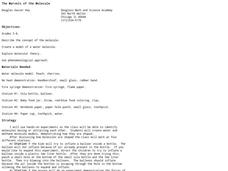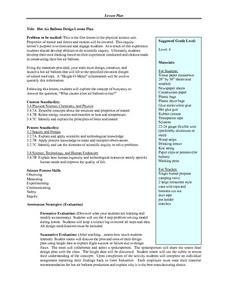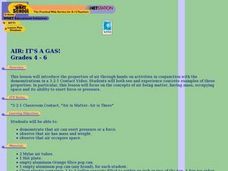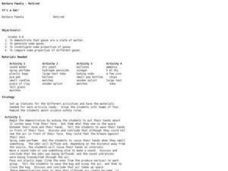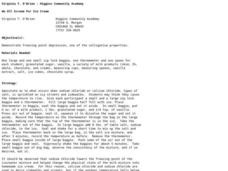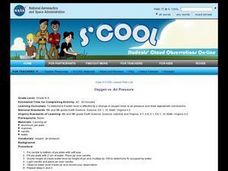Curated OER
Air Pressure
Learners participate in a series of demonstrations about Bernoulli's principle. They explain how air pressure varies with air speed. They write a detailed lab report about the activity. This is a great way to explore this concept.
Colorado State University
Why Can Warm Air "Hold" More Moisture than Cold Air?—Vapor Pressure Exercise
Does it feel a little humid in here? Learners assume the role of water vapor in the atmosphere as they explore the differences between warm and cold air. They roll dice to determine their level of energy, which determines if they stay...
Curated OER
The Marvels of the Molecule
Students experiment with common substances to observe molecular behavior. In this molecular properties lesson, students move through four stations as they try to inflate a balloon inside a bottle, pour water from a jar, and observe how...
Curated OER
Hot Air Balloon Design Lesson Plan
Sixth graders discuss what they know and what they want to know about hot air balloon using a KWL chart. They then use a wide array of materials to design a hot air balloon that will lift successfully in cooperative groups referring to...
Curated OER
Air Is All Around Us!
Students design an instrument to show that air is all around. In this air lesson plan, students research, construct, and present a design that proves that air is all around, even though they can't see it or touch it. A teacher and self...
Curated OER
Properties of Air
Fourth graders participate in a demonstration lesson using bubbles in which they determine that air fills the bubbles. Next, they work in small groups as they they experiment with the properties of air at separate work stations. After...
Curated OER
Properties of Air
Students conduct investigations to demonstrate and learn that air takes up space, and puts pressure, or pushes, on everything around it. They conduct experiments to learn about feeling air pressure and measuring air pressure. Prior to...
Curated OER
Properties of Soil: Original Lesson Plan
This lesson is an investigation of soil properties, particularly texture, color and space for air and water. Student inspect soil samples found in their locale, perform several tests to determine different properties, and involves a ...
Curated OER
The Magic School Bus Goes on Air
Learners conduct an experiment to determine the properties of air based on a Magic School Bus adventure. They inflate and deflate zipper plastic bags to show that air takes up space and holds objects. They associate this with riding a...
Curated OER
Air is something
Students recognize that air has the properties of mass and volume. They predict, observe, and evaluate the effect of the air on various objects, using bubbles and bubble wands.
Curated OER
Air -- Is It Really There?
Students work together to perform simple experiments discovering the properties of air. They share their results with their classmates. They examine how engineers use the properties of air to clean the air of pollutants.
Curated OER
Air: It's a Gas!
Young scholars investigate the properties of air through hands-on activities in conjunction with the demonstrations in a 3-2-1 Contact Video.
Curated OER
Air Masses
Learners are given maps depicting two or more air masses and they then categorize bodies of air by temperature and moisture characteristics. They recognize large regions of similar type air. Students are given a map of air temperatures...
Alabama Learning Exchange
Air is All Around You
Pupils investigate the mysteries of air. In this science lesson, students participate in hands-on activities that require them to use the scientific inquiry model to study air.
Alabama Learning Exchange
Float or Sink?
Experiment with mass and density as scholars figure out what makes things float or sink. First, they watch a podcast introducing these concepts. Be sure to use the comprehension question to test their understanding. Young scientists...
Green Education Foundation
How Loud is Too Loud?
Ever wonder how loud a sound has to be to cause damage? Young scientists explore sound properties by researching decibel levels. They discuss how sound is perceived by our ears and our brains and why it can cause negative health effects...
Curated OER
It's a Gas!
Students investigate gases and their properties by completing 4 activities. In this gases lesson plan, students perform activities to show that gases take up space, they diffuse, and that odors and vibrations pass through gases. They...
Curated OER
Have a Ball with Bernoulli II
Third graders explore the work of Daniel Bernoulli through experiment and background information. In this Bernoulli lesson plan, 3rd graders participate in air pressure experiments. Students record their observations of the effects of...
Curated OER
Non-Compressibility of Water
Students will observe a property of water. For this inquiry-based properties of air lesson, students observe how a change in water pressure impacts the positioning of an eye-dropper in the water container and they make hypotheses about...
Curated OER
We All Scream for Ice Cream
Young scholars investigate the freezing point depression of water while making ice cream. In this colligative properties lesson plan, students make ice cream using ice, salt and water to freeze milk and sugar. They measure the...
Curated OER
Is Air a Fluid?
Students discuss the physical properties of fluids and then demonstrate that air carbon dioxide and oxygen) is a fluid by creating currents.
Curated OER
Oxygen vs. Air Pressure
Learners conduct an experiment to determine if water level is affected by a change in oxygen level or air pressure.
Curated OER
Air: You Can't See It, But It's There!
First graders investigate that air occupies space by performing experiments that show this principle. Students are provided with a lunch bag. Students open the lunch bag and look inside. Students determine if there is anything in their...
Curated OER
How Can You Tell One Clear Gas From Another?
Fifth graders perform experiments to determine the identity of an unknown gas sample. In this chemistry instructional activity, 5th graders fill balloons with air, oxygen, hydrogen, and carbon dioxide. They use mass and reactivity to...




